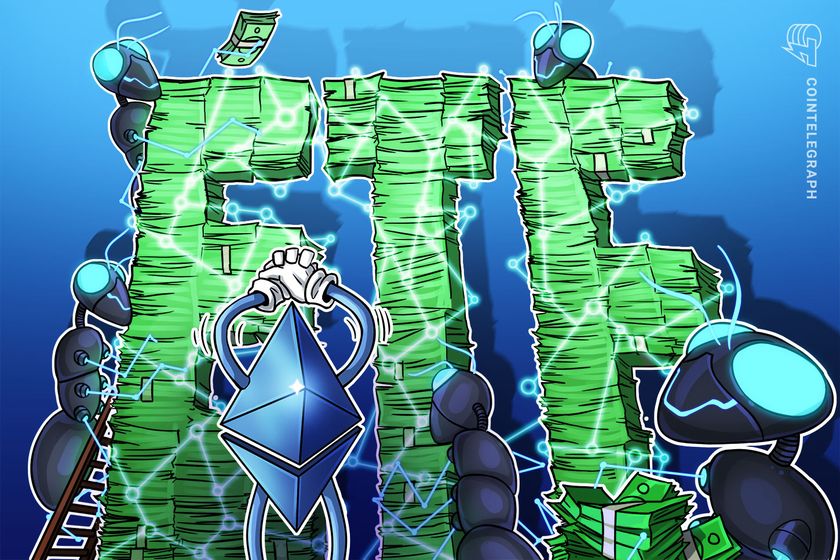Ethereum Merge prompts miners and mining pools to make a choice

The Ethereum Merge to PoS is slated for the third week of September, eliminating PoW mining. Experts weigh in on how mining pools and miners would be impacted.
The Ethereum blockchain is all set to make its highly anticipated transition from its current proof-of-work (PoW) mining consensus to proof-of-stake (PoS). The Merge date is officially scheduled for Sept. 15–16 after the successful final Goerli testnet integration to the Beacon Chain on Aug. 11.
At present, miners can create new Ether (ETH) by pledging a huge amount of computing power. After the Merge, however, network participants, known as validators, will be required to instead pledge large amounts of pre-existing ETH to validate blocks, creating more ETH and earning staking rewards.
The three-phase transition process began on Dec. 1, 2020, with the launch of the Beacon Chain. Phase 0 of the process marked the beginning of the PoS transition, where validators started staking their ETH for the first time. However, Phase 0 didn’t impact the Ethereum mainnet.
The terminal total difficulty has been set to 58750000000000000000000.
This means the ethereum PoW network now has a (roughly) fixed number of hashes left to mine.https://t.co/3um744WkxZ predicts the merge will happen around Sep 15, though the exact date depends on hashrate. pic.twitter.com/9YnloTWSi1
— vitalik.eth (@VitalikButerin) August 12, 2022
Phase 1, the integration of the Beacon Chain with the current Ethereum mainnet was scheduled for mid-2021; however, due to several delays and unfinished work on the developer’s end, it got postponed to early 2022. Phase 1 is all set for completion in the third quarter of 2022 with the Merge. This phase would eliminate PoW-based miners from the ecosystem and make many current PoW-based projects redundant.
Phase 2 and the final phase of the transition would see the integration of Ethereum WebAssembly or eWASM and introduce other key scalability features, such as sharding, which developers and co-founder Vitalik Buterin believe would help Ethereum achieve processing speeds on par with centralized payment processors.
In anticipation of the Merge, there has been active chatter about what would happen to the PoW chain after the mainnet transitions to PoS. Many centralized exchanges have thrown their support behind the Merge but have stated that if PoW-based chains gain traction from miners, then exchanges will list the forked chain and support them.
Weighing in the possibility of a successful hard fork
Chandler Guo, an influential Bitcoin (BTC) miner, was among the first to bring out a case for the PoW Ethereum chain post-Merge. In a tweet on July 28, Guo shared a screenshot of Chinese miners saying that PoW Ethereum is coming soon.
ethpow will coming soon pic.twitter.com/v9eAbWO2BZ
— Chandler Guo (@ChandlerGuo) July 27, 2022
However, Buterin has denounced those who advocate for this forking, claiming that it would just be a ploy for miners to make easy money without benefiting humanity. Perhaps most importantly, it seems that much of the decentralized finance (DeFi) ecosystem has no intention of supporting Ethereum PoW, which is reason enough for Ethereum advocates to take a conservative approach to the Merge.
Shane Molidor, CEO of crypto exchange platform AscendEX, believes there is a definite chance of forks, with PoW miners already showing interest, telling Cointelegraph:
“Some Ethereum miners may believe it’s in their best interest to fork the newly PoS Ethereum chain back to PoW in order to keep using their expensive mining hardware. If this were to occur, ETH holders would likely be airdropped ‘PoW ETH’ in addition to their original ETH holdings that merged to PoS.”
He added that if a fork does not occur, it is likely that other PoW chains such as “Ethereum Classic and GPU-hungry applications like Render Network gain hash power from ex-PoW Ethereum miners.”
Daniel Dizon, CEO of noncustodial liquid ETH staking protocol Swell Network, believes the opposite and sees a very small chance of a successful fork. He explained to Cointelegraph that even if miners manage to fork the PoW chain and keep it alive, there is very little chance for them to remain as profitable as they were before the Merge:
“Ultimately, the value of Ethereum as a network goes far beyond simply its consensus mechanism. It extends to highly defensible characteristics, such as its user base, developer activity, ecosystem, infrastructure, capital flow and more.”
He added that a full PoS Ethereum has consistently had the support of the vast majority of the community and society more broadly, given improved environmental, social and corporate governance outcomes post Merge. Moreover, he said that major “DeFi protocols will simply choose not to recognize the ‘Ethereum PoW’ variant over post-Merge Ethereum, which is another major sticking point for the fork.”
The Ethereum mining industry is worth $19 billion, according to an estimate by crypto research group Messari. The report said that mining alternative PoW coins will not be economically sustainable for most existing Ethereum miners. The total market capitalization of GPU-mineable coins, excluding ETH, is $4.1 billion, or roughly 2% of ETH’s market cap. ETH also makes up 97% of total daily miner revenue for GPU-mineable coins.
Large mining pools are shifting to staking
The transition is not that drastic for mining pools when compared to individual miners because pooling firms never generated their own computing power and never invested money in soon-to-be-outdated mining equipment. However, these businesses do have human capital, which is the infrastructure required to organize the pooling of resources, find new consumers, and maintain the satisfaction of thousands of current clients. Existing Ether mining pools are already well on their way to transitioning to staking pools.
Ethermine, one of the largest Ether mining pools, announced a beta version of Ethermine Staking in April. Nearly half of the hashing power, or computer power, currently used to mine Ether is shared between Ethermine and F2Pool.

The second largest Ether mining pool, F2Pool, announced the end of the PoW mining era in the second week of August. The firm said whether to support the Ethereum fork or not is no longer important. It will let the miner community decide.
Dizon believes there will be a far-reaching impact on mining pools, and many of them might turn to other PoW chains, but a majority will focus on the staking industry: “We do see that many of the mining pools are pivoting their operations towards Ethereum staking, which is set to experience exponential growth off the back of the Merge.”
Related: The Merge: Top 5 misconceptions about the anticipated Ethereum upgrade
Will Szamosszegi, CEO and founder of Bitcoin mining platform Sazmining, told Cointelegraph that the idea of an Ethereum fork is very ideologically driven — many Ethereum enthusiasts consider the costs of a PoW protocol greater than its benefits:
“One issue Ethereum miners will face after the Merge is that the cost of their overhead may exceed the revenue they could earn by mining alternatives to Ethereum. They could instead invest their computational resources into Web3 projects that their mining algorithms and hardware can support.”
Ethereum Classic vs. the forked Ethereum PoW?
Antpool, the mining pool affiliated with mining rig giant Bitmain, announced that it had invested $10 million in the development and apps for Ethereum Classic. Moving ETH’s valuation into a PoS model will change how ETH accrues value from mining to staking and allow investors to earn passive income — like interest in a fiat savings bank.
Kent Halliburton, chief operating officer of Sazmining, told Cointelegraph, “Ethereum miners are currently split on what to do after the Merge. Some will continue to mine Ethereum Classic, which will still use a proof-of-work consensus mechanism following Ethereum’s Merge. Other miners are employing their resources towards higher-level crypto projects.”
Related: Economic design changes will affect ETH’s value post-Merge, says ConsenSys exec
Ethereum Classic (ETC) seems to be a more prominent choice for many Ether miners over the forked Ethereum chain. Chinese miner Guo, who has made his intentions clear about forking a PoW chain, was reminded by some on Crypto Twitter that ETC could be a better alternative than a forked token.
With just under a month remaining before the official Merge, PoW miners and mining pools have already started to look for alternatives. Many believe the chances of a forked chain are negligible, given there is no certainty over its value even after a successful fork. Others predict a rush in mining activity on Ethereum Classic. Ether mining pools seem to be least impacted by the transition, as many of them have shifted their focus on the expanding staking ecosystem.









